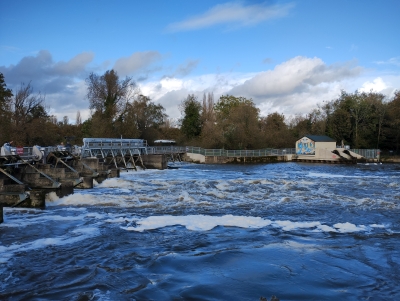A hydroelectric scheme converts the energy of falling water into electrical energy. How? By using the force of the water to turn the blades of a turbine. The turbine is linked to a generator which produces electricity.
The amount of electricity depends on how far the water falls (the ‘head’) and how much flows through the turbine. The larger the head and flow, the more electricity can be generated.
In Reading, the river Thames usually falls about 1.4 m when it flows over Caversham weir. Our hydroelectric scheme was built at the end of the weir to take advantage of this head. It uses two Archimedes screw turbines. Up to 3.1 m³ of water flows through each one every second. Each turbine is connected to a generator via a gearbox. The plant is rated at 46kW electrical output, and in an average year we estimate it will generate 320 MWh of electricity. It does this without producing climate-heating emissions.

We’re preparing detailed pages to explain how Reading Hydro was planned and built, and how it is now operated. This may take some time! In the meantime:
- Visit the site – the hydro scheme is easily seen 24/7 from public land, and information boards explain all about Reading Hydro.
- Make a virtual tour! Read the information boards online and watch videos of how we operate the plant and clear rubbish from the intake screens.
- Experience at high-speed how the site was cleared; how the turbine-channels, fish pass and turbine house were built; and how the turbines were installed by watching our fantastic construction videos (huge thanks to Eleanor Cowling for producing these, and to Ian Germer, Sophie Paul and other volunteers for photos and video footage)
- Check our FAQs – there’s lots more information there.
